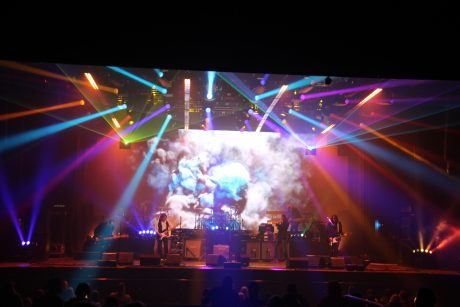
Pink Floyd Tribute Band Puts on Additional Shows with Additional Protocols
For two decades, St. Louis-based Pink Floyd tribute band El Monstero would put on a couple of Christmas shows selling out the 2,000-seat Pageant Theater. For the last seven years, Logic Systems has supplied the lighting, special effects, video and supplementing the house audio system. Then came this year … but neither the venue, Logic, nor the band was going to let a little thing like a worldwide pandemic stop them. The shows went on, and to say there were a few adjustments would be understatement.
Not to the show itself – it was a full production with all the trimmings. More on that later. And before we get through the door, let’s see what the Pageant team did to the place first. The owners had an HVAC company modify the air handlers to maximize air movement, and now it’s cycling in outside fresh air five and six times an hour. Then on October 17, the theater was the location of a test concert put on by Klance Unlimited and VeroShield, a new off shoot of Dodd Technologies. In addition to the Pageant’s owners, 150 event professionals from the area attended the event including some Live Nation people. Klance Unlimited, the St. Louis-based staging and rigging company, are now also in the COVID-19-prevention biz having partnered with VeroShield. “Since the shutdown, Klance Unlimited has been forced to pivot and find other methods to keep the doors open,” says Kyle Vogt of Klance. “We have done a great deal of research to help get our industry back in the fast track of having live events again.”
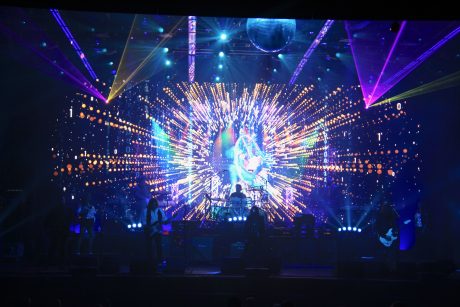
At the demonstration some of their products and services were adopted by the theater, including System-3 120-Day Disinfectant, UV Light disinfection units, and UVC Air Purifiers. The VeroShield High Output Unit was used on stage. The UVC Air, made for close quarters, were used backstage, in the greenrooms, around catering, and front of house. Vogt, in giving a tour of the precautions before the El Monstero show, demo’d the VeroShield UVC Locker 2448, which was a road case fitted with 180 watts of UV lights. Gear like microphones, guitars, radios, etc., get zapped/sterilized. “It can disinfect almost anything in a one minute,” Vogt says.
The Pageant’s owners went for some, but not all, of what was demonstrated. “At our level, we don’t have the money [for all of it], and you reach a point where you start to question what is effective,” co-owner Pat Hagin says.
The Pageant next sat down with the city of St. Louis to see what they could do. “The city has been pro-active and involved in this process,” Hagin says. The 336-seat show is basically 15 percent capacity, with the city approving the floor plan.
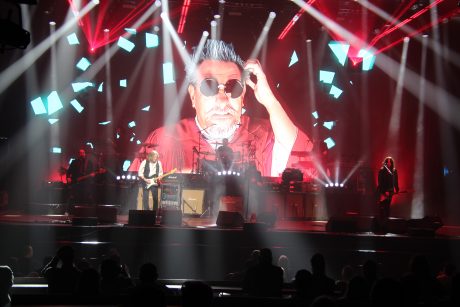
Right this Way
“The budgets are stripped way down, they’re at about 25 percent of what they would normally be.” Logic’s Chip Self says. So while it might have made financial sense to cut back from a full-production, Logic is not skimping on a single fixture or video panel. “It’s important to the band and myself to keep the production value to the same high standards that the audience expects,” Self says. “We all agreed we needed to uphold the brand.” Other math involved the number of crew: Instead of a 50-person crew loading in in two days, it was a five-person crew taking five days to put it in. The band and crew were in a bubble for a week, and then on December 17, the 12 shows began on a rotation of three shows on, one night off. “We kept the circle tight,” Self adds.
Now let’s get you seated for the show. First, you bought the ticketless tickets on-line in groups of four (and a few twos). You stood outside with your group six feet apart from the other groups. You went through a borrowed metal detector thus eliminating the staff’s need to wave the wand over you. Inside, you answered the questions we’re now all so used to answering and you got your temperature taken. Once you’re checked in, you’re given a map of the theater with your seats marked. You go directly to those seats, do not pass go, do not collect $200. You sit. If you want a drink, you go to one of the six service stations (“we’re not calling them bars” says Hagin). There, the floor is marked, and you stand six feet apart. When you’re second in line, there are pencils and paper for you to write your order down. When you get to the bartender, you pass the paper to them under the plexiglass. You take up to four drinks and go back to your seats. Bathroom? Two at a time. And also, any time you’re not sitting and drinking, you must have your mask on.
“This is an experiment to see if the protocols and systems we put in place work,” Self says, noting that it’s “hard to prove a negative” in terms of what is effective and working. All the products and services currently coming out on the market “is expensive, but if it can get you six months’ worth of business you wouldn’t otherwise get, it’s a bargain.” He says the Pageant has done a good job, and so far “hats off to the fans they are adhering to the rules. It’s gone really well.”

Production
“The show is different every year, but the best description is that it’s Pink Floyd crossed with a monster truck rally. Everything is bigger, bolder, more bombastic.” With the music of Pink Floyd, it’s all about the visual. “About 200 Absen A7 panels were brought in to create the giant upstage wall, and a sizable rigging and lighting rig,” Self says. Two panels are missing where Self, who designed the look and ran the lights, put two X-Laser Mercury 5-watt lasers. “I’m new to lasers, so I’m just really starting to figure out what I can do with them. I already know how to get a ton more functionality out of them than when I started. It’s been a fun learning process.” He adds that the missing panels are “an interesting bit. Your mind will connect those dots pretty easily. Used well, it can be a powerful tool.”
He says that part of the reason he does the show is the freedom the band gives him to create. “I like to use it as R&D – I can try things and take bigger risks.” Related is what he did with Phillips ShowLine 640 and 620 strip lights. He used them in four 28-foot lines running US/DS. “I’m using them as wash fixtures, and other than some fixtures FOH and on the deck, they are the sole source of wide wash in the rig. They are so large and so powerful, I can really get some unique looks.” He also has a bitmap layer for them and can run them as low-res video. “There are a few instances where I’m using them to expand the visual from the video wall into the ceiling.” In addition to integrating two visual elements, it makes your perception of the screen size and shape completely change. It’s a trick I wasn’t sure was going to work.”
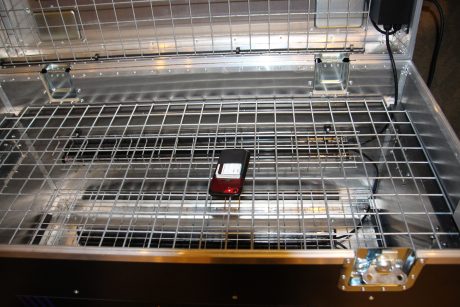
His work with the band has been “an evolution. The first time it was very collaborative, but over the years they have started to just let me do my thing and, just ask what I’m doing.” Self designs the entire production, working with video director Jon “LJ” Edward. “L.J. is a fanatic in terms of coming up with his own content. He’s super creative and comes up with all sorts of nutty stuff.”
This is certainly true – the video-dominated show was as imaginative as it was bombastic, with Edward concocting a hybrid of content for his ninth year with the band. “This year we shot video of aerialist and played them on the songs Breathe, Shine On You Crazy Diamond, and Any Color You Like,” he says. “We also shot videos of our cops and headmaster and played them back on Another Brick in the Wall, Part 2.” Normally these scenes would be performed live by actors on stage but were filmed because of COVID. That specific filming was about 15 percent of the video content, and another 60 percent was original content he created using After Effects and Premier Pro. The rest was stock motion graphics and loops he got through the VJ community. “A decent amount of that was edited live with effects through the Resolume VJ Software. Any of the audio reaction effects is through FFGL source files within that software.” He built the video console he runs it all through.
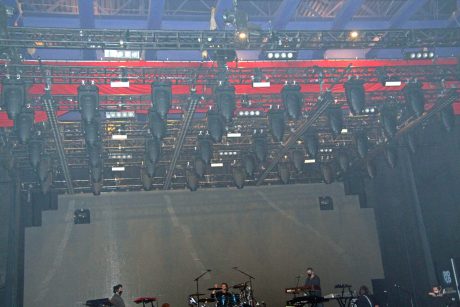
And yet … despite the full production, a great sounding band, and an enthusiastic audience, it still all happened to a house that was 85 percent empty. Self notes that in addition to the smaller crowd, the energy is way different as everyone is restricted to sitting in their chairs. “It’s like doing finish work with a jackhammer,” he quips.
These shows are part of a bigger “Glimmer of Normalcy” series, and while the El Monstero shows are certainly the biggest in many ways, after a little break in January and February, Hagin says they are hoping to resume these, gradually increasing the number of people who can attend if COVID cases go down, vaccinations go up, and “and the pandemic begins to fade.”
As far as the Pageant’s motivation to try anything, Hagin says, “you can’t say it’s financial. I have not looked at the numbers too hard and in a way, I don’t want to! My goal is to not lose any more money than we are already losing, but there are other concerns.” He mentions the local artists who are missing a lot of work. “We want to do something for them, obviously. Next, we also wanted to give our staff an opportunity to work.” (Those who are working these events are doing so voluntarily.) And finally, keeping the Pageant’s name in front of the public was important. “I think considering those three goals, it’s mission accomplished.”
Photos and Story By Kevin M. Mitchell
Lighting Gear
- grandMA3 full size (primary) and grandMA3 lite (backup)
- (40) Vari*Lite VLZ Spot
- (12) Chauvet Maverick MK1 spot
- (20) Chauvet Rogue R2 wash
- (24) Phillips ShowLine 640
- (4) Phillips ShowLine 620
- (9) Phillips Nitro 510
- (9) Thomas 4-lite
- (7) Ayrton Versapix-RS
- (2) DF-50
- (2) FQ-100
- (2) X-Laser Mercury 5-watt lasers
- (1) 36″ Mirror ball & motor
Audio
- Digico SD-12 (FOH)
- Midas Pro-2 (MON)
- Vue Audiotechnik AL-12 main PA
- Vue Audiotechnik AL-4 sidefill



